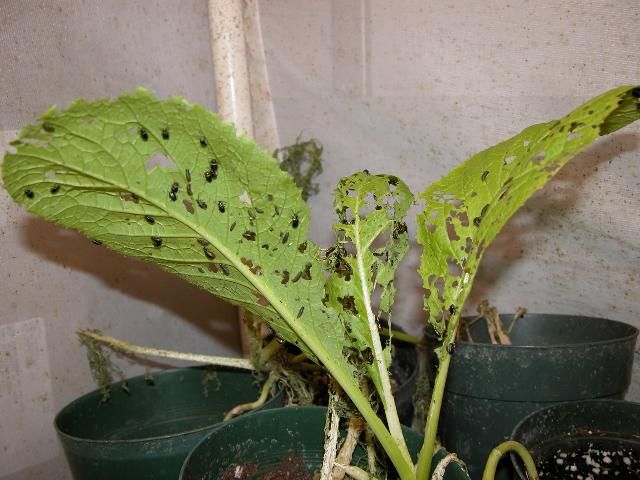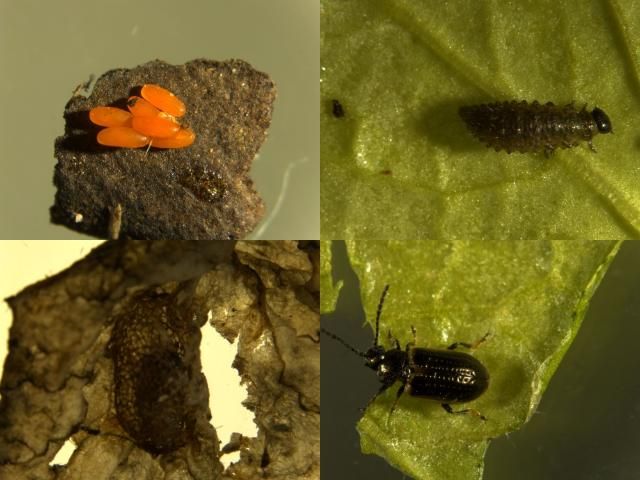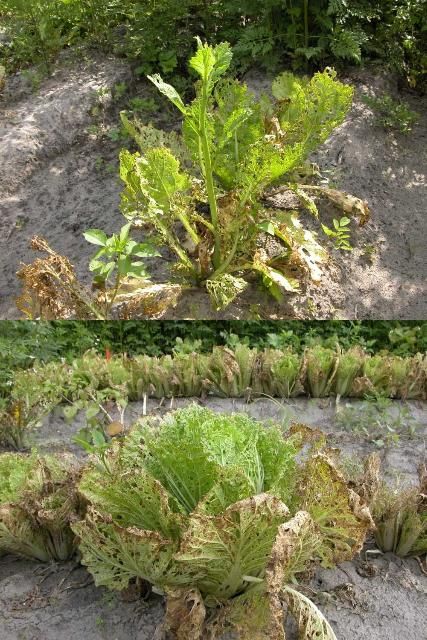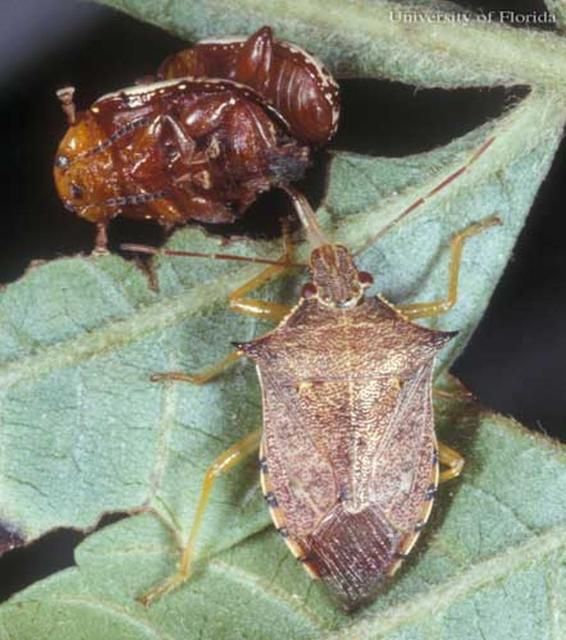Introduction
The yellowmargined leaf beetle (YMLB, Figure 1), Microtheca ochroloma Stål, is a pest of cole or cruciferous crops that is native to South America (Woodruff 1974). The first report of the beetle in the United States comes from Chamberlin and Tippin (1949), who recorded it feeding on several cruciferous crops in Mobile, Alabama, in March of 1947. The beetle has since spread throughout the Gulf Coast from Texas to Florida (Drees 1997) and up into Georgia (Guillbeau 2001) and North Carolina (Kritz 1997). It has also been reported from Illinois (Marche 2013) and California (Gilbert et al. 2011). In Florida, it was first reported from Tampa in April of 1972 feeding on watercress, Nasturtium officinale R. Br. (Woodruff 1974). The purpose of this document is to provide biology and management information on this pest for growers, Extension agents, and anyone else interested in it.

Yellowmargined leaf beetle is not considered to be a major pest in conventionally grown cruciferous crops because it is susceptible to a wide range of insecticides. However, it poses a significant threat to the growing organic industry in the southeastern United States. It is a particular problem on Asian greens such as mizuna, mibuna, and napa cabbage, as well as on other high-value cruciferous crops like turnip, mustard, and watercress (Bowers 2003).
Life Cycle
Yellowmargined leaf beetles are active throughout the cooler months. This period can extend from October until May in the southeastern United States. Eggs (Figure 2) are typically laid on the soil surface or under leaf litter (Bowers 2003). Some eggs are laid on the host plant, usually on the stem. They are often laid in small groups and can be laid singly as well. Eggs are approximately ~ 1 mm (~1/32 in) in length, elongate, and bright orange in color. They hatch in an average of 7.8 days (Ameen and Story 1997a).
Larvae (Figure 2) vary in color from yellowish-brown to almost black. The larval stage lasts an average of 10 days (Ameen and Story 1997a) with most larvae progressing through 3 to 4 instars. A small number (~5%) will progress through a fifth instar (Ameen and Story 1997a). Early-instar larvae tend to cluster together. Later-instar larvae become solitary.
Before pupating, mature larvae spin a black web around themselves that turns brown as it dries. This web causes the pupae to resemble debris or frass (Figure 2). The prepupal stage, in which the larva spins its web and forms a pupal case, lasts an average of 3 days. The pupal stage itself lasts an average of 5.6 days. Pupation usually occurs on the underside of leaves or on the soil surface beneath leaf litter or other debris.
Adult YMLBs (Figure 2) are brown or black. The margin, or edge, of the elytra (wing covers) is usually yellow in color, which is where the beetle gets its common name. This margin can appear more reddish than yellow in some individuals. They are approximately 5 mm (~3/16 in) in length, but length can vary slightly. Depending upon host plant, adults can live for a couple weeks up to several months (Ameen and Story 1997c). Females can lay several hundred eggs in their lifetime.

Injury
Both adult and larval YMLBs feed on the leaves of their host plants (Figure 3). When left untreated, they will skeletonize the entire leaf and, eventually, the whole plant. They will also feed on the ribs, stems, and roots when the leaf material has been exhausted. Interestingly, in napa cabbage (Figure 3), the beetles feed from the outside leaves in (E. M. Rhodes personal observation).

In Florida, the beetles are much more common in the spring and, therefore, the injury they inflict is more severe. However, beetles are active from October through April and, in cooler years, early to mid-May. Beetle populations decrease rapidly once the temperature is consistently above 80°F. Beetles will not develop at temperatures below ~45°F (Manrique et al. 2012), but in Florida temperatures rarely remain below 45°F long enough to impact the beetle population.
During wet winters, injury is less severe and YMLBs appear to be less common. Yellowmargined leaf beetles may prefer a drier environment, which is the norm for Florida during the months the beetle is active. It is also possible that the rain washes the beetles off the plants. In this case, frequent rainfalls would reduce the time the beetles are on the plants, which would, in turn, reduce the amount of injury to the plants and cause the beetles to appear to be less prevalent.
Host Preference
Yellowmargined leaf beetles have a definite host preference. Adult beetles were more attracted to volatiles from napa cabbage and turnip compared with cabbage and collards (Balusu and Fadamiro 2011). Higher numbers of adults and larvae were recorded from napa cabbage and turnip compared with cabbage and collards. Additionally, higher amounts of injury were seen on napa cabbage and turnip. Similarly, Ameen and Story (1997b) reported that adult beetles preferred turnip, mustard, and radish over cabbage and collards. Larvae preferred turnip and mustard over radish, cabbage, and collards. Females laid more eggs on turnip compared with collards and more eggs per day on turnip and mustard compared with collards (Ameen and Story 1997c). Beetles reared on cabbage died out after 3 generations, whereas they were able to produce at least 4 generations on turnip, mustard, radish, and collards (Ameen and Story 1997a). Japanese greens such as mizuna and mibuna along with watercress also appear to be preferred host plants.
Monitoring
There are currently no traps available to monitor for this beetle. Therefore, direct scouting of plants is necessary. Both adults and larvae prefer the underside of leaves. On preferred host plants like turnip and napa cabbage, YMLB populations can increase rapidly, so weekly scouting is recommended. Examine plants for YMLB adults and larvae. It is also important to check for injury because adults will fall to the soil if temperatures become too cold (~40°F or less), and both larvae and adults can be washed off plants by heavy rainfall (E. M. Rhodes personal observation).
Management
The current management practice for YMLB is weekly applications of insecticides. On conventional farms, the beetle is usually kept in check by insecticides applied to control other pests. Organic options are limited. Check with your local UF/IFAS Extension agent for current recommendations.
Turnips can be planted as a trap crop (Balusu et al. 2015). An area planted with a susceptible cruciferous crop can be surrounded by a row of turnip plants. Planting of the turnip plants should be timed so that turnip plants are at least 2 weeks older than the cash crop. The turnip plants should be monitored and sprayed to reduce the population of YMLB when the population reaches an average of 1 adult per plant. This keeps the population from getting so high that beetles begin to move from the trap crop into the cash crop. Insecticide applications will still be necessary in the cash crop, but the number of sprays for the season should be reduced. Although the turnip greens in the trap crop will likely be unmarketable, some of the turnips may be big enough to sell.
It is important to note that intercropping does not help in managing this pest, at least in mizuna (Bowers 2003). The beetle is a major pest on an organic farm in north Florida that intercrops heavily (E. M. Rhodes personal observation), so this is likely true for other susceptible cruciferous crops as well. Similarly, the use of straw mulch actually increases beetle populations and should be avoided (Manrique et al. 2010).
A few generalist predators will feed on YMLB. In its native range, the predatory stinkbug Stiretrus decastigmus was found feeding on YMLB (Poncio et al. 2010). Predatory stinkbugs native to the United States, including the well-known and commercially available spined soldier bug (Figure 4), Podisus maculiventris (Say), have been observed feeding on YMLB. Montemayor and Cave (2012) recommend releasing 10 or 4 first-instar spined soldier bugs per six plants if the plants will have = 7 leaves or = 6 leaves, respectively.

References
Ameen, A. O. and R. N. Story. 1997a. "Biology of the yellowmargined leaf beetle (Coleoptera: Chrysomelidae) on Crucifers." Journal of Entomological Science 32: 478.
Ameen, A. O. and R. N. Story. 1997b. "Feeding preference of larval and adult Microtheca ochroloma (Coleoptera: Chrysomelidae) for crucifer foliage." Journal of Agricultural Entomology 14: 363.
Ameen, A. O. and R. N.Story. 1997c. "Fecundity and longevity of the yellowmargined leaf beetle (Coleoptera: Chrysomelidae) on crucifers." Journal of Agricultural Entomology 14: 157.
Balusu, R., E. Rhodes, O. Liburd, and H. Fadamiro. 2015. "Management of yellowmargined leaf beetle Microtheca ochroloma (Coleoptera: Chrysomelidae) using turnip as a trap crop." Journal of Economic Entomology 108: 2691–2701.
Balusu, R. R., E. M. Rhodes, A. Majumdar, R. D. Cave, O. E. Liburd, and H. Y. Fadamiro. 2017. "Biology, ecology, and management of Microtheca ochroloma (Coleoptera: Chrysomelidae) in organic crucifer production." Journal of Integrated Pest Management 8: 14; 1–10.
Bowers, K. 2003. Effects of within-field location of host plants and intercropping on the distribution of Microtheca ochroloma (Stål) in Mizuna. M.S. thesis. University of Florida.
Chamberlin, F. S. and H. H.Tippins. 1949. "Microtheca ochroloma, an introduced pest of crucifers, found in Alabama." Journal of Economic Entomology 41: 979.
Drees, B. M. 1997. Yellowmargined leaf beetle on leafy greens in Texas. http://insects.tamu.edu/ extension/bulletins/uc/uc-006.html.
Fasulo, T. R. 2005. Yellowmargined leaf beetle, Microtheca ochroloma Stål (Insecta: Coleoptera: Chrysomelidae). EENY-348. http://entomology.ifas.ufl.edu/creatures/veg/leaf/yellowmargined_leaf_beetle.htm.
Gilbert, A. J., J. Williams, and J. Sohal. 2011. "Microtheca ochroloma Stål 1860, a newly introduced leaf beetle to California (Coleoptera: Chrysomelidae: Chrysomelinae)." Pan-Pacific Entomologist 87: 201.
Guillebeau, P. 2001. Crop profile for leafy greens in Georgia. USDA Crop Profiles. https://ipmdata.ipmcenters.org/source_report.cfm?view=yes&sourceid=376
Kritz, R. W. 1997. Annual summary, plant disease and insect clinic—insect data for 1996. North Carolina State University. No longer online.
Manrique, V., R. Diaz, C. Montemayor, D. Serrano, and R. D. Cave. 2012. "Temperature-dependent development and cold tolerance of Microtheca ochroloma (Coleoptera: Chrysomelidae), a pest of cruciferous crops in the southeastern United States." Annals of the Entomological Society of America 105: 859.
Manrique, V., C. Montemayor, R. D. Cave, E. A. Skvarch, and B. W. Smith. 2010. "Effect of straw mulch on populations of Microtheca ochroloma (Coleoptera: Chrysomelidae) and ground predators in turnip Brassica rapa in Florida." Florida Entomologist 93: 407.
Marche, J. D. 2013. "First record of Microtheca ochroloma Stål (Coleoptera: Chrysomelidae) from Illinois, USA." The Coleopterists Bulletin 67: 602.
Montemayor, C. O. and R. D. Cave. 2012. "Evaluation of the predation capacity of Podisus maculiventris (Hemiptera: Pentatomidae) on Microtheca ochroloma (Coleoptera: Chrysomelidae) in field cages." Journal of Economic Entomology 105: 1719.
Oliver, A. D. and J. B. Chapin. 1983. "Biology and distribution of the yellowmargined leaf beetle, Microtheca ochroloma Stål, with notes on M. Picea (Guerin) (Coleoptera: Chrysomelidae) in Louisiana." Journal of the Georgia Entomological Society 18: 224.
Poncio, S., S. T. B. Dequech, V. S. Sturza, R. A. D. Lissner, L. F. Perlin, P. K. Rosalino, and L. do P. Ribeiro. 2010. "First report of Stiretrus decastigmus in Brazil preying Microtheca ochroloma." Ciencia Rural 40: 1203.
Woodruff, R. E. 1974. A South American leaf beetle pest of crucifers in Florida (Coleoptera: Chrysomelidae). FDACS-DPI Entomology Circular 148.